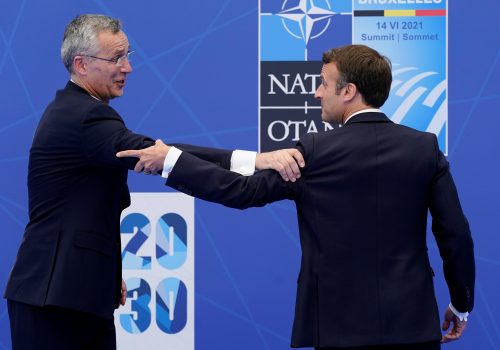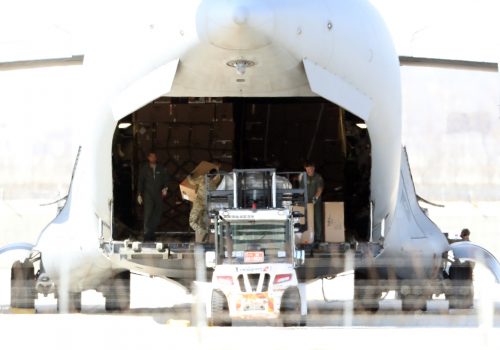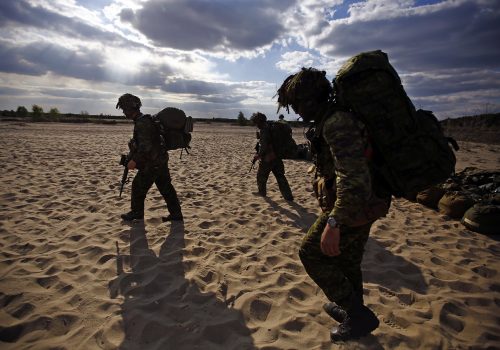Why ‘human security’ matters for tomorrow’s conflicts
What do soldiers do when they encounter a child armed with explosives? How can we prevent girls from being taken as brides for terrorists? And how can we prepare for displacement due to climate change?
These and other dilemmas helped inform NATO leaders’ decision last month to include in their final communiqué an important reference to “human security,” a concept central to building more inclusive and resilient societies capable of managing crises and maintaining collective defense.
It didn’t get as much attention at the Brussels summit as transatlantic cooperation on issues related to Russia, China, climate change, and cybersecurity, but including human security as one of the summit outcomes was a major step for the Alliance and one that deserves closer attention.
Stemming from a United Nations Human Development Report in 1994, human security holds that what makes individuals and communities safe also contributes to national security. Since the 1990s, academics have debated whether the term “over-securitizes” the concept of human development. Either way, it is taking on new relevance in military circles today.
As a former US military instructor and NATO advisor, I have trained thousands of soldiers to analyze threats to human beings from non-state actors and irregular warfare. Such lessons are sought after by partner nations working to address the same challenges.
For example, the need for human security is clear in eastern Ukraine, where numerous schools have been damaged and classes have been disrupted due to the conflict with Russia. In some cases, Ukrainian forces that are eager to comply with NATO standards have occupied schools as fortified structures, which is contrary to the law of armed conflict. In the absence of educational opportunities, Russian influences are filling the gap by recruiting young men and women into militarized youth groups. Ending the conflict in Ukraine will not be possible in the long run without preventing young people from being drawn into battle.
At the summit, the NATO leaders’ communiqué defined human security as focusing on the “risks and threats to populations in conflict or crisis areas and how to respond to them.” In the same vein, the leaders reaffirmed their support for the Protection of Civilians policy, which aims to minimize threats to civilians in NATO mission areas.
Subscribe for events and publications on transatlantic security
Sign up for updates from the Atlantic Council’s Transatlantic Security Initiative, covering the debate on the greatest security challenges facing the North Atlantic Alliance and its key partners.
But also prominent was their commitment to promoting “the meaningful participation of women in all aspects of peace and stability” as part of the Women, Peace, and Security (WPS) agenda. This included endorsing a new policy on Preventing and Responding to Conflict-Related Sexual Violence, a critical tool for reducing the use of sexual violence as a tactic of war.
Such steps are particularly important given the stark reality of today’s Alliance. The day after the summit, Secretary General Jens Stoltenberg addressed a Women Political Leaders Summit, stating that more needs to be done to boost the participation of women in NATO forces, which remains around a mere 12 percent.
Societies are comprised of people from different gender, age, race, language, and social groups, and ensuring their equal representation in political negotiations and peace processes leads to more sustainable outcomes. Building a more inclusive security force also strengthens public trust in defense institutions.
Focusing on human security is an important crisis-management tool that can strengthen resilience—which, according to the NATO framework, is defined as “a society’s ability to resist and recover from… shocks,” requiring a combination of civil preparedness and military capacity.
While NATO recognizes that resilience is a national responsibility, the Alliance has methods to assess whether countries are adequately prepared for major civil emergencies based on their capacity to ensure the continuity of government services; sustain energy, food, and water supplies; maintain telecommunications and transportation systems; manage population movements; and deploy adequate health care services to address mass casualties.
Last month’s NATO communiqué also emphasized that resilience is about “the ability to detect, prevent, mitigate, and respond to vulnerabilities,” which often come from a variety of sources and pose different threats to different groups of people. In this regard, the COVID-19 crisis has given the world a test run in resilience. But it is not the worst-case-scenario: Future threats, such as bio-terrorist attacks or nuclear confrontation, could be far more deadly.
Looking ahead, the commitments to human security made at this year’s summit suggest the concept will be an important element of the Alliance’s Strategic Concept for 2022. NATO can move this concept forward by developing a comprehensive human security policy that provides strategic guidance on different aspects of the human domain.
NATO Land Command in Turkey has already created a human security section within its stability and outreach branch. The section provides mobile training on children, gender, civilian protection, and cultural property to partner nations including Morocco, Tunisia, the United Arab Emirates, Kyrgyzstan, and Ukraine. Taking this approach to other NATO command structures will require leadership in the days ahead.
While human security didn’t make headlines at the summit, understanding how to achieve it will be crucial to preparing for the next crisis—whether it’s another pandemic or a major war.
Sarah Dawn Petrin is a former advisor to the US military and NATO on developing strategy, policy, and doctrine for the Protection of Civilians and Women, Peace, and Security. She has twenty years of operational experience in conflict zones in Africa, Asia, Eastern Europe, and the Middle East.
Further Reading

The Transatlantic Security Initiative, in the Scowcroft Center for Strategy and Security, shapes and influences the debate on the greatest security challenges facing the North Atlantic Alliance and its key partners.
Image: Second Lt. Johanna Shaffer shares a cookie with an Afghan child while under the security of Marines assigned to 3rd Battalion, 8th Marine Regiment (Reinforced), during her all-female team's first mission in Farah Province, Afghanistan, in this February 9, 2009, US Marine Corps handout photo. Photo by Monty Burton/US Marine Corps via Reuters.


